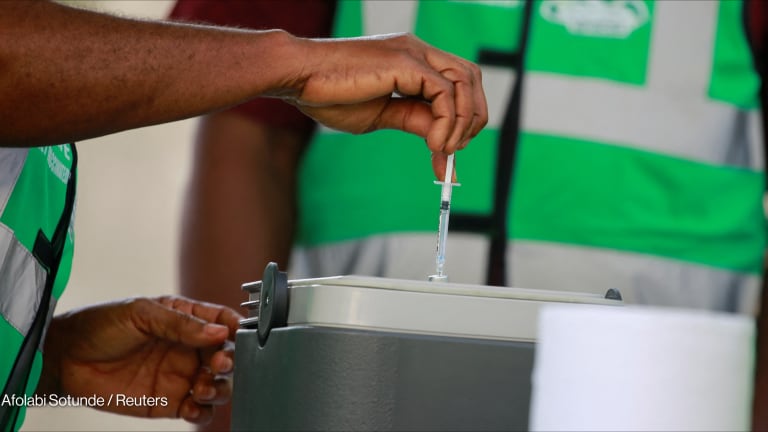
The COVAX Humanitarian Buffer, a “last resort” mechanism to ensure COVID-19 vaccine access to vulnerable groups in humanitarian settings, was due to deliver Johnson & Johnson shots for refugees at the Thailand-Myanmar border at the end of 2021. But the doses never arrived. Now, sources confirm to Devex the deal has been canceled and that the refugees have been vaccinated by the Thai government.
Sign up for Devex CheckUp
The must-read weekly newsletter for exclusive global health news and insider insights.
A Gavi, the Vaccine Alliance spokesperson said the cancellation came after it was clear that the Thai government would cover these populations in its national vaccination plan, and that COVAX is now “actively working to re-allocate these doses.”
There was initial confusion as to what happened to the vaccines. Aid agencies in Thailand have been saying doses had not arrived in the country, but it was unclear why. On Thursday, the local NGO that made the application to distribute the doses told Devex that it had canceled its request.
COVAX is a global initiative that was designed to enable equitable access to COVID-19 vaccines, and the humanitarian buffer was established alongside the Inter-Agency Standing Committee in 2021 to prioritize reaching those considered the most vulnerable and at risk of being neglected by national vaccination efforts.
IASC estimates put the number of people at risk of exclusion from COVID-19 vaccinations at approximately 167 million. The buffer aims to provide “enough doses” to high-risk groups among these populations, which IASC estimates at about 33 million to 50 million people. The first batch of 1.6 million doses delivered through the buffer were sent to displaced populations in Iran in November.
The application was canceled “about a week ago … because the majority of the migrants in Tak Province are now vaccinated,” said Dr. François Nosten, director of the Shoklo Malaria Research Unit and board chair of its humanitarian arm The Borderland Health Foundation, which made the application.
COVAX, partners call for changes in donated doses in 2022
They said that “the majority of the donations to-date have been ad hoc, provided with little notice and short shelf lives,” making it “extremely challenging for countries to plan vaccination campaigns and increase absorptive capacity.”
There are around 97,000 refugees in Thailand, the majority of whom are people from ethnic minority groups in Myanmar. Three of the country’s nine refugee camps are located in Tak province, which sits on the Thai-Myanmar border. Dr. Nosten said the province’s public health teams and the district hospitals had already vaccinated the migrant population there. According to Our World in Data, 70.5% of the country’s population has received a double dose of the vaccine.
Darren Hertz, Thailand director of the International Rescue Committee, which was supposed to be involved in the vaccination program, also told Devex that “IRC is no longer engaged in the COVAX program as the Royal Thai Government is providing sufficient vaccine stock for the 80,000 Burmese refugees living in nine camps.”
After repeated requests for information, a Gavi spokesperson confirmed to Devex via email that the application has been canceled.
“During the process of working with the Humanitarian Buffer applicant and national stakeholders on logistics to support the completion of this application, it has become clear that the Government of Thailand — which is not a COVAX participant — is planning to meet this need within its national vaccination plan. Therefore, the nongovernmental organization made the decision to withdraw its application,” the spokesperson told Devex.
It was reported that the U.S. government played a key role in facilitating the potential delivery. A manufacturing mishap last year meant the quality of a batch of J&J vaccines was questioned. But, once assessed and approved for use by the Food and Drug Administration, Biden’s administration offered the donation to the buffer.
Gavi failed to comment on whether any other deliveries apart from Iran had been made through the buffer.
“Everything has got delayed. The barriers to absorption and uptake can be really considerable.”
— Amanda Harvey-Dehaye, Médecins Sans Frontières task force leader, Access to Covid Tools AcceleratorIndemnity clause, a major barrier
Applications for the buffer opened in May 2021, but a number of aid organizations have been reluctant to apply, or faced challenges in putting in a request due to legal requirements.
The whole process behind the buffer is too complicated said Amanda Harvey-Dehaye, task force leader at Médecins Sans Frontières for the World Health Organization’s Access to Covid Tools Accelerator. “I don’t think the regular Gavi procedures can apply to this. It’s got to be lightened up. It’s got to go faster, be more reactive, less paper heavy,” she explained.
For example, COVID-19 vaccine manufacturers require that humanitarian organizations receiving vaccines sign an indemnity agreement, freeing manufacturers from any liabilities in case of any adverse side effects. While countries that have received doses via COVAX have signed this agreement, the situation is not as straightforward for aid organizations, which may be unable or willing to take on such a risk.
Gavi and the IASC have called on manufacturers to waive this requirement for humanitarian agencies, and some, such as J&J, and Chinese vaccine manufacturers Sinopharm, Sinovac, and Clover, as well as the Serum Institute of India — for Covishield, its version of the Astrazeneca COVID-19 vaccine — have agreed to work with COVAX to waive them for humanitarian organizations.
'We right now are basically out of money' for COVAX, says Gavi
COVAX needs at least $5.2 billion in new funding over the next three months.
While Gavi has “gone out of their way to get the waiver,” Harvey-Dehaye said, “it’s so terrifyingly dangerous” that waivers beyond the buffer aren’t being considered. If manufacturers don’t assume full liability for their COVID 19 vaccines, “ultimately affordable access to all medical products and patients’ interests are at stake," an explainer put together by MSF on COVID-19 vaccines and manufacturer liability states.
The Alliance for International Medical Action, or ALIMA, a medical humanitarian NGO that operates in seven countries in Africa, has not applied for doses under the buffer for two reasons. One is the buffer, the other that vulnerable groups such as refugees are not explicitly excluded from national vaccination programs. Dr. Kader Issaley, director of operations at ALIMA, said removing liability from the equation could encourage more aid organizations to request doses through the buffer.
“The manufacturer should take the responsibility,” he told Devex. Vaccine distribution is a major challenge in the countries the NGO operates, and it can be difficult to get a predictable supply to plan deployment even if vulnerable populations are technically eligible under a national vaccination program.
“We are fully dependent on [the] ministry of health. We negotiate with them, we say, ‘What can you give us?’ But the main problem is that even the ministry of health, they don't have visibility [on supply],” he said. This means a long wait for doses, which sometimes arrive close to their expiration.
Just because the buffer is a humanitarian mechanism, it doesn’t mean it can escape all the same difficulties and delays being seen generally with vaccines, including supply, said Harvey-Dehaye. “Everything has got delayed. The barriers to absorption and uptake can be really considerable,” she said.
Waiting for doses
But there’s another way for humanitarian agencies to overcome the legal barrier. In Pakistan, the government has shown willingness to work with the Pakistan Red Crescent Society and the International Federation of Red Cross and Red Crescent Societies to get the COVAX doses.
Dr. Abhishek Rimal, IFRC Asia Pacific emergency health coordinator, said Pakistan’s government has already signed the indemnity clause for Sinopharm, the vaccine they’re set to receive from the buffer. It’s bound for some 300,000 people — migrants, including undocumented migrants; people who are displaced; and Afghan refugees and asylum seekers — in the three hard-to-reach areas of Khyber Pakhtunkhwa, Balochistan, and merged areas along the border with Afghanistan.
“They are willing to cover the vaccine coming in under that umbrella [buffer] as well,” Rimal said, adding that the government has also expressed willingness to support custom clearance and other requirements needed to get the vaccines in the country.
“It had solved a lot of problems, which many of the humanitarian organizations would have been a bit reluctant in signing such [a] clause by themselves,” he said, noting that government cooperation offers “a different confidence in an organization like our national Red Cross Red Crescent Society, IFRC, etc. to go ahead.”
The organizations applied for doses from the buffer in September, and received a “preliminary approval” around the turn of the year. They are expecting the vaccines to arrive mid-to-late March, a timeline confirmed to Devex by a Gavi spokesperson.
But if those deliveries don’t take place in March, Rimal said another batch is scheduled in May. “Sometimes there is an unwanted delay, which is not in the hands of anyone. But we are trying our best to get it in March,” he said.






